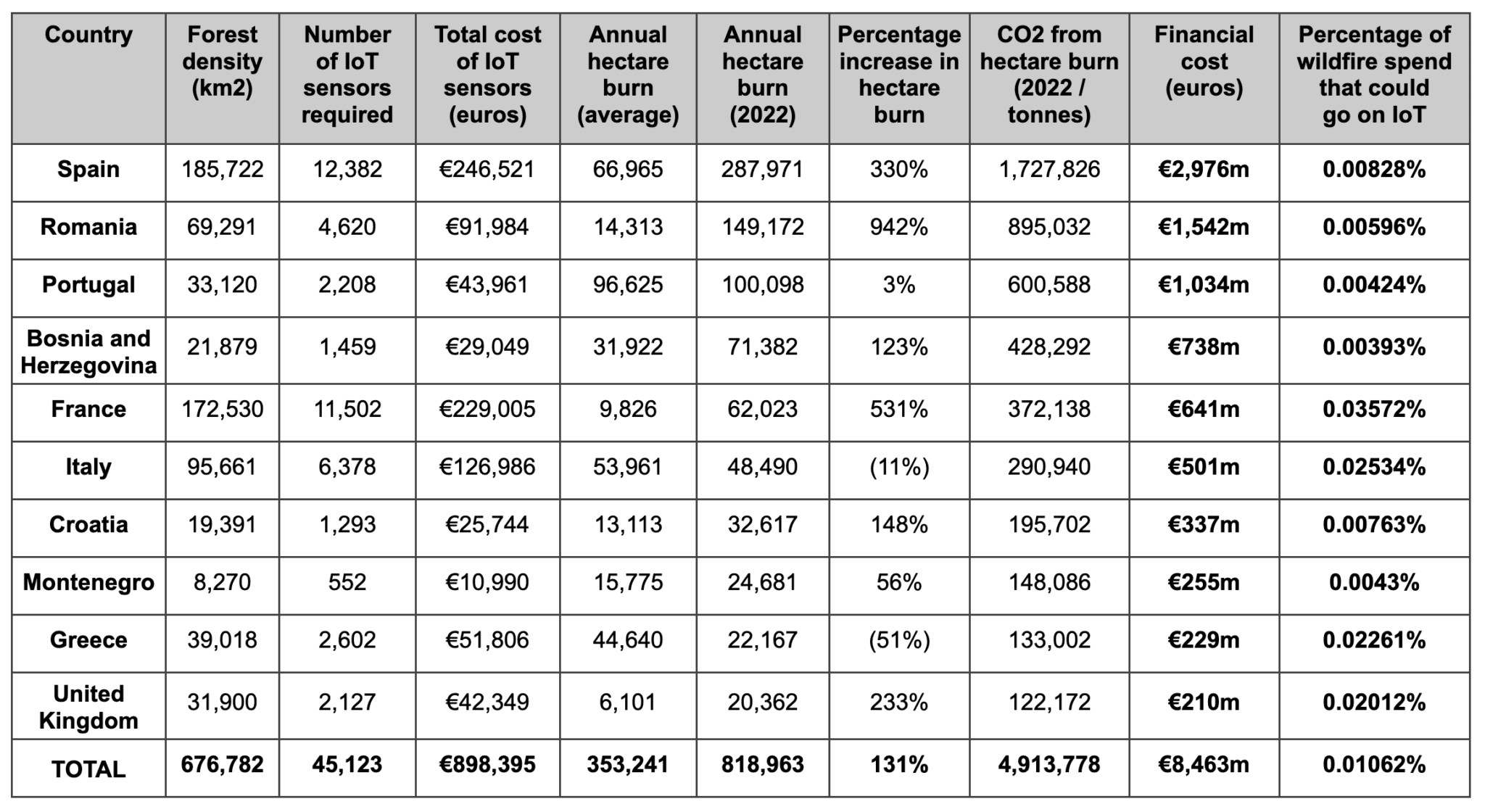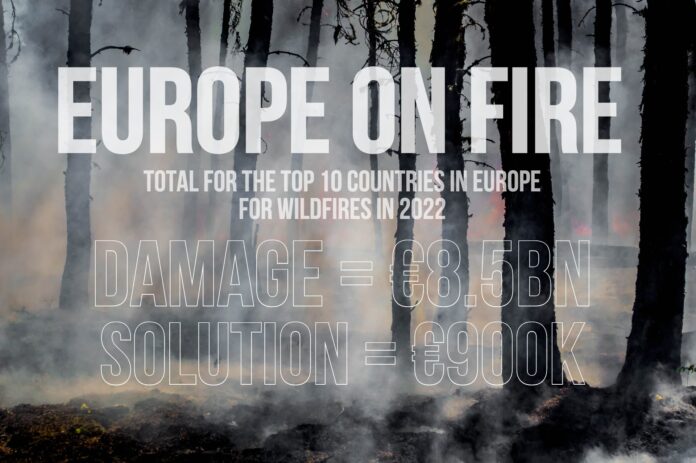Some of the most interesting IoT use cases on the conference circuit in the past months have been about wildfire monitoring. Through the heat of summer, as parts of Europe burned, smart people from clever companies took to the stage at various events to make the case for their IoT solutions, promising effective ways to send crucial early warnings about the breakout of forest fires, and to track their spread and halt their progress.
Australia and the US, and the Philippines and Canada, know very well the devastation of scorching heat – and lightning and barbecues and cigarettes and arson – on woodlands and wildlife. Southern Europe – Spain, Italy, Greece – know this, too. But 2022, in particular, made all of Europe aware, with record-breaking temperatures, and unprecedented wildfires across the whole continent. The numbers bear this out.
Data from the European Forest Fire Information System (EFFIS) says 287,971 hectares of forest have burned in wildfires in Spain in 2022, compared with an annual average of 66,965, as recorded between 2006 and 2021– an increase of more than 300 percent, or almost four-and-a-half (4.3) times the average ‘burn’. But this was the picture across the continent in 2022 – with increases of over 900 percent in Romania, 500% in France, and 200% in the UK.
Indeed, Romania, with around two-fifths of the forest density of Spain, and a more northerly position, saw more than twice the average annual burn of Spain, a wildfire hotspot, in 2022; Bosnia and Herzegovina, with around a ninth of the forest density of Spain, saw a 2022 burn that was about equal to the Spanish average. And 2022 is not finished yet, even if the fire season is (in early September) about done, and climate change will make it a precedent.
The question, as put by Switzerland-based Distrelec Group, is: ‘how can governments future-proof against the devastating loss of life of both humans and wildlife?’ The answer, as per the IoT pitches on the conference circuit through the summer, is to invest in IoT-based sensing and AI-based analytics solutions. The Swiss electronics distributor has crunched the EFFIS numbers, and put them through an IoT cost-of-ownership spinner.
Its methodology, as best we can work it out, is as follows: it has said that, on average (according to WWF, citing an article in IQ FireWatch), every hectare of land burned costs around €10,334; it multiplied this number by the number of hectares burned (according to EFFIS) in European countries in 2022 to calculate a total cost to each; at the same time, it divided their square-kilometre forest-density (using World Bank data) by 15 (square kilometres), as the typical forest-range of an IoT sensor, to calculate the number of sensors required to cover a country’s forests; and costed the total IoT forest-coverage for each country according to a standard metric for bulk IoT purchases.
Further: it calculated the IoT cost as a percentage of the 2022 wildfire damage in each country. Total CO2 emissions from wildfires in 2022 were calculated at 15 tonnes per 2.5 hectares of ‘burn’ (using numbers from Germany-based LoRaWAN developer Dryad, one of the most persuasive speakers on the summer IoT trail in 2022). The message is not that IoT will prevent all wildfires, and all damage from them, but only that it can help to establish an early warning system, and curtail much of the damage.
The point, as well, is that IoT is cheap, compared to the cost – in damage and resources – of wildfires. Spain spent €2.975 billion this year on tackling wildfires, according to the figures. Romania spent €1.541 billion and Portugal spent €1.034 billion. Even the UK, with an average burn of only (!) 6,101 hectares per year, spent €210 million to fight a 2022 burn of 20,362 hectares.
In an email, Distrelec commented: “To cover the total forest density of [Spain], 12,382 sensors would be required, totalling €246,525.62 – which is just 0.00828 percent of the amount spent tackling forest fires this year… To cover the forest density of [Romania], 4,620 sensors would be required, totalling €91,984.20 – just 0.00596 percent of the amount spent on tackling wildfires this year alone.” The full read-out is below; most of the numbers are from Distrelec; Enterprise IoT Insight has filled some of the gaps.
It continued: “Implementing IoT sensors in Portugal would cost €43,961.28, just 0.00424 percent of the cost of damage… Other European countries that would particularly benefit from early detection wildfire sensors include Bosnia and Herzegovina, France, Italy, Croatia, Montenegro, Greece, and the UK.”
Bigger picture: the top 10 countries for wildfires in Europe saw 818,963 hectares of forest eviscerated in 2022, an increase of 131 percent on the average annual devastation – with 4.9 billion tonnes of CO2 chucked into the sky as a result. The cost to collectively fight this summer-long continent-wide blaze was €8.5 billion. For less than a million euros – (only!) €898,395 – they could purchase 45,123 IoT sensors to sharpen their intelligence and focus their efforts – and tackle worsening forest fires before they become uncontrollable.
If there was ever a ‘no-brainer’ business case for IoT, then this must be it.


